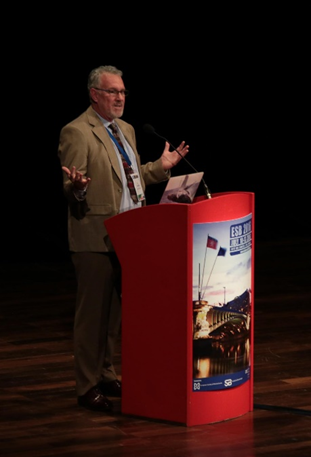Remembering Christopher Rae Jacobs 1965-2018

At the World Congress of Biomechanics in Dublin we mourned the loss of Professor Christopher Jacobs who passed away just a few days before the congress on 1st July 2018. He was born in 1965 and this year should have been a great time for both his career and his family life. Sadly, he lost his life due to cancer a few days before his baby girl was born – Rae Christina Jacobs. Many words have been said about Chris at the World congress, and since then, within the many scientific communities of which he was a part. Here we would like to highlight his special relationship with the European Society of Biomechanics.
Chris studied at Stanford University with a giant of Biomechanics – Dennis Carter, where he obtained his PhD in Mechanical Engineering. He then took up his first position as a young and enthusiastic faculty member of the Milton S. Hershey Medical Centre, Penn State University. It was at Penn State that Chris became fascinated by cell biomechanics and mechanobiology. He submitted an early paper on the effects of fluid flow on bone cells to the ‘ESB Research Award’, which subsequently became the S.M. Perren award; he won the award and presented it in a highly entertaining way at the conference in Toulouse, where he showed us images of the chocolate-themed features of the town of Hershey, such as Hershey-kisses lamp-posts, interspersed with parallel plate flow chambers and calcium signalling data. The Internationally leading quality of this paper has been demonstrated by its many citations – 505 times to date in google scholar. The images of Hershey he presented persuaded at least two of us past ESB council members – myself and Paulo Fernandes, to work with Chris at Penn State. Although he didn’t work in Europe himself, Chris had a huge affection for ESB as a society and attended the meeting regularly, sent his group members and frequently hosted European colleagues. Chris loved to travel and experience different environments and cultures. He was open minded, friendly and inclusive and fought against discrimination in any form.
In the year 2000, Chris moved back to California as a faculty member of Stanford University and director of a centre focused on Bone and Joint Rehabilitation at the Palo Alto VA where his interest in an understudied mechanosensing organelle – the primary cilia began to take off. Chris then joined the department of biomedical engineering at Columbia University in 2008 and became a leader in primary cilia research gaining large NIH grants on the topic and becoming increasing visible and renowned to both the biomechanics and biology communities. He managed to effortlessly cross the interdisciplinary barrier that frustrates many of us in this field. He published around 200 papers in the fields of biomechanics and mechanobiology with an h-index of 50 but his key legacy will be the way he inspired the next generation of mechanobiologists many of whom are ESB members today.
Chris was a wonderful and optimistic mentor he would always see the positive side of any adverse scientific event, an experiment going wrong was the chance to make a new discovery and grant being rejected would open up a whole new avenue for his research. I remember at a recent meeting complaining about how much time I had ‘wasted’ on a grant that had just been rejected and he firmly insisted that no time spent writing a grant was ever wasted, that it always gave you an opportunity to formulate and improve your ideas and make the next project even better. Although I last worked directly with Chris in 2000 we remained firm friends ever since and my experience was by no means unusual – at the memorial event in Dublin so many of his current friends present were former supervisees and mentees because once you worked with Chris you had a friend for life. He was extremely loyal and supportive and never forgot the struggles of being a young investigator.
Chris’ last interaction with the ESB was at the 40th Anniversary meeting in Lyon where he was a plenary speaker, once again he fascinated people with a discussion of cellular mechanosensing mechanisms and how his group were beginning to manipulate these for health benefits. He presented his book ‘Introduction to Cell Mechanics and Mechanobiology’ with co-authors Hayden Huang and Ronald Y. Kwon. Latepostr, I found out that he was already ill during his trip to Lyon but only few colleagues knew about it. He joined in all the social events with his usual enthusiasm and we had some excellent dinner conversations about his sporting activities, the crazy state of British and US politics and how happy he was to have met his wife – Claire Julian.
Chris represented the best side of the biomechanics community – curiosity driven research, the ability to have fun with a scientific project, collaboration and team work and allowing young minds to shine. It is a terrible loss to the community that he died so young but we can be grateful that he had such a full and fulfilling life that we will benefit from his work and collegiality for years to come.
Gwendolen Reilly ESB president 2014-2016.







